Athena Review Vol. 5, no. 1
Records of Life: Fossils as Original Sources
36. Early Miocene Apes
Early Miocene Hominoidea in Africa
Proconsul
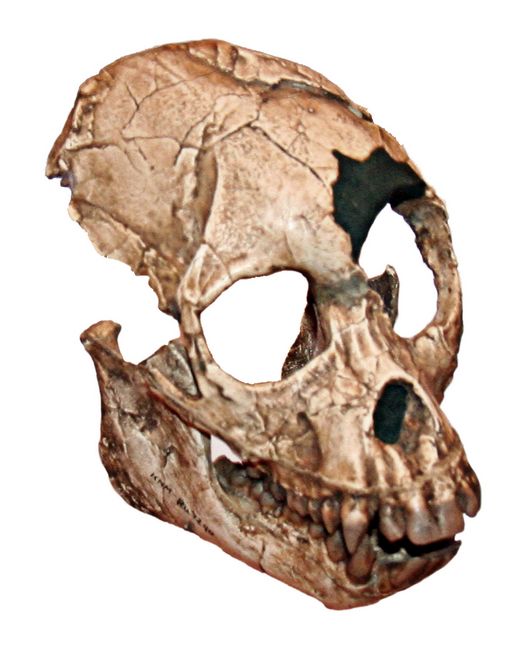 Proconsul hesoloni was a Miocene ape dating from 23-14 mya. The species, at first named Proconsul africanus,
had been previously described by Hopwood in 1933. The Leakey expedition
of 1947–1948 to Rusinga Island in Lake Victoria uncovered more species
of Proconsul, including the
first nearly complete skull, found by Mary Leakey in 1948. The
skull (KNM-RU-7290), dated at about 16 mya, is now at the Kenya
National Museum. In 1951 Whitworth found more Proconsul fossils on Rusinga. In 1992 Alan Walker grouped all Proconsul finds in the species of hesolini.
Proconsul hesoloni was a Miocene ape dating from 23-14 mya. The species, at first named Proconsul africanus,
had been previously described by Hopwood in 1933. The Leakey expedition
of 1947–1948 to Rusinga Island in Lake Victoria uncovered more species
of Proconsul, including the
first nearly complete skull, found by Mary Leakey in 1948. The
skull (KNM-RU-7290), dated at about 16 mya, is now at the Kenya
National Museum. In 1951 Whitworth found more Proconsul fossils on Rusinga. In 1992 Alan Walker grouped all Proconsul finds in the species of hesolini. Proconsul was a fruit eater that partly resembled a chimpanzee, but had a flatter face, a larger size and probably a shorter, stiffer lower back. It weighed on average about 18 kg (40 lbs). The skull was round and smooth on top. Based on the cranium, this species had an external brain surface much like that of gibbons and cercopithecoid monkeys. Proconsul had a dental formula of 2.1.2.3 on both the upper and lower jaws. The molars had thin enamel, and the canines were sexually dimorphic.
Fig.x: Skull of Proconsul from Rusinga Island, Kenya (YPM cast; photo: Athena Review)
The hands were similar to those of a human, having not yet evolved into the long-fingered, short-thumbed hooks of living apes. Rather than walking on its knuckles, Proconsul likely continued to walk on its palms. Proconsul was seriously considered by the Leakeys to be a candidate for a common ancestor of humans and apes.
Mary and Louis Leakey
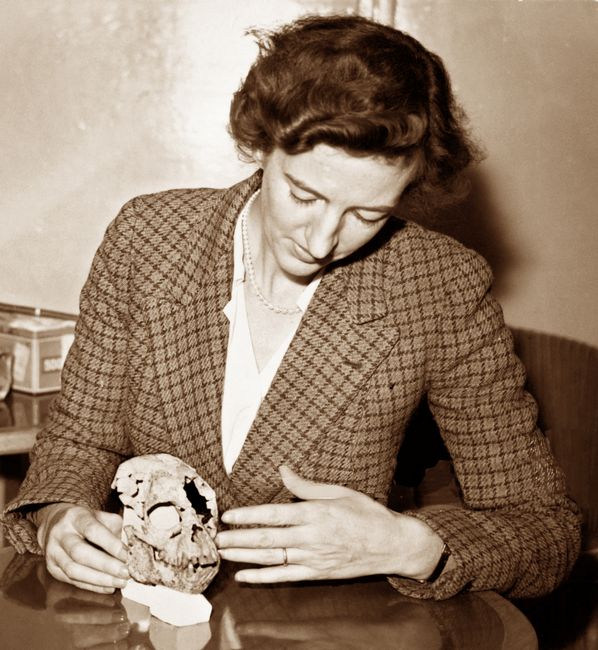 Mary
Douglas Leakey (born Mary Nicol; 1913-1996) was a British
paleoanthropologist who was born in England and moved to East Africa
with her husband, Louis Leakey. Among her notable discoveries were
the first fossilised Proconsul skull, a Miocene ape found at Rusinga Island, Kenya in 1948, and the skull of the robust Australopithecine named Zinjanthropus ("nut-cracker man") found at Olduvai Gorge in Tanzania in 1959.
Mary
Douglas Leakey (born Mary Nicol; 1913-1996) was a British
paleoanthropologist who was born in England and moved to East Africa
with her husband, Louis Leakey. Among her notable discoveries were
the first fossilised Proconsul skull, a Miocene ape found at Rusinga Island, Kenya in 1948, and the skull of the robust Australopithecine named Zinjanthropus ("nut-cracker man") found at Olduvai Gorge in Tanzania in 1959. For much of her career she worked with her husband, Louis Leakey, at Olduvai Gorge, where they uncovered numerous fossils of early hominins, as well as the early stone tools now classified as the Olduwan Industry. In 1972, after the death of Louis, Mary Leakey became director of excavations at Olduvai, often working with their son Richard Leakey and his wife Meave as well as the paleontologist Alan Walker. She discovered fossilized footprints at the Laitoli site, from hominins least 3.75 million years old. During her career, Mary Leakey also discovered fifteen new species of animals.
Fig.x: Mary Leakey with skull of Proconsul (photo ca. 1948).
Louis Seymour Bazett Leakey (1903-1972) was a British paleoanthropologist and archaeologist who, together with his wife Mary, made a series of discoveries at Olduvai Gorge providing crucial evidence of the early evolution of hominins in East Africa. He also established programs of research into palaeoanthropology and primatology in Africa, teaching and working with a number of prominent scholars (including members of his own family).
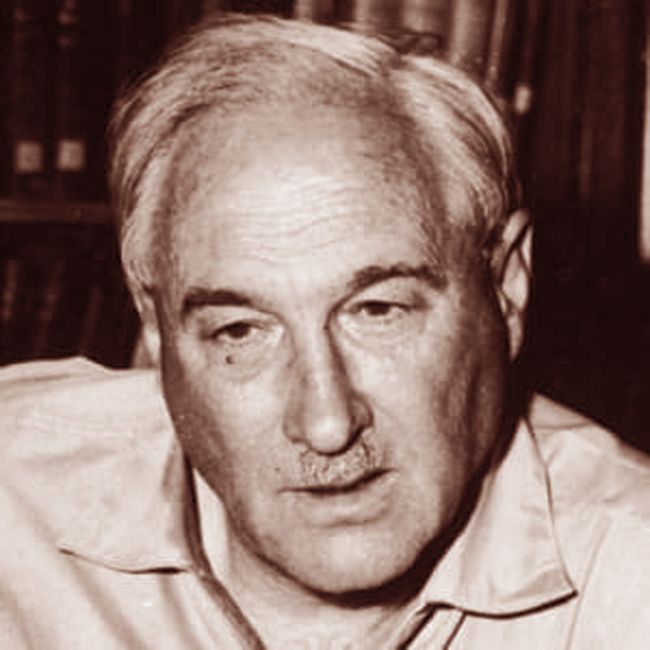
Born in Kenya of missionary parents, Louis Leakey studied paleonotology and archaeology at Cambridge University in England. He first worked at Olduvai in the early 1930s. After returning to England with his wife Mary, in 1937 they travelled to Kenya to study the Kikiyu tribe. During World War II Louis worked in Intelligence for the Kenyan governent. In the late 1940s, the Leakeys were able to return to paleoanthropological research, with an expedition to Rusinga Island where in 1948 Mary found the first skull of the Miocene ape Proconsul. In 1951 they began work at Olduvai Gorge in Tanzania, located in the rift valley where Pliocene and early Pleistocene levels were exposed.
Fig.x: Louis Leakey (photo: ca.1960).
Among the many important fossils of early human ancestors (hominins) discovered at Olduvai were Zinjanthropus, a form of Australopithecus robustus, found by Mary Leakey in 1959; and Homo habilis (named by Raymond Dart as "handy man") a transitional form beween australopithecines and Homo, found in 1962.
Turkanapithecus
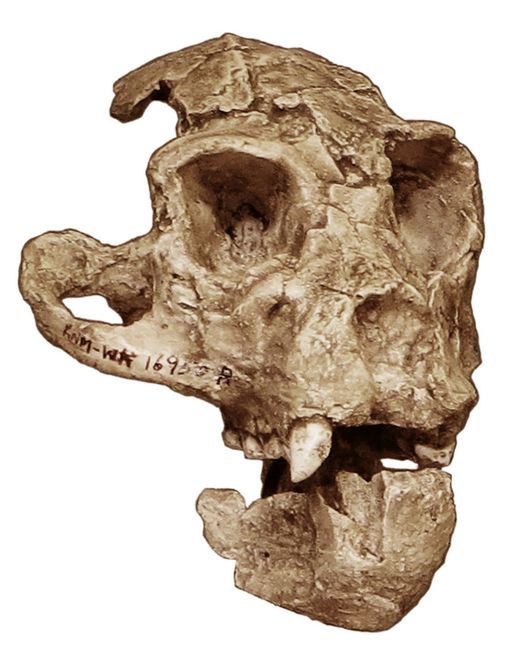
Turkanapithecus kalakolensis is a Miocene hominoid found by Richard and Meave Leakey in 1986 at Kalodirr, in the Lothidok Formation at West Turkana, Kenya, dated at 20.43-15.97 mya. The type specimen (KNM-WK 16950A and B) is a partial skull and mandible.
Turkanapithecus is a member of the Proconsulidae family, and considered to have lived as a scansorial insectivore.
Fig.x: Skull of Turkanapithecus kalakolensis (Nat.His.Mus.Paris, cast)
.
Afropithecus
Afropithecus turkenensis is a Miocene hominoid found in 1986 at Kalodirr, a site near Lake Turkana in northern Kenya, dated about 17.5 mya (16 - 18 mya). A total of 46 specimens of Afropithecus included cranial, mandible, dental and
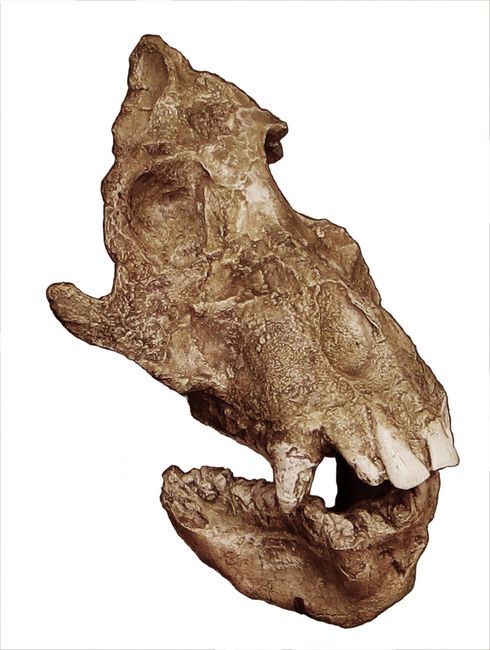 post-cranial remains, reported by Richard and Meave Leakey and Alan Walker in 1988.
post-cranial remains, reported by Richard and Meave Leakey and Alan Walker in 1988. A. turkanensis was a large hominoid with relatively thick tooth enamel. It shared some postcranial features with Proconsul nyanzae, and some cranial features with Aegyptopithecus zeuxis. A. turkanensis was a primitive, arboreal quadruped similar to P. nyanzae, with primitive facial morphology similar that of Aegyptopithecus zeuxis (Leakey et al. 1991; Simons et al. 2007).
Fig.x: Skull of Afropithecus turkenensis (Nat.His.Mus.Paris, cast)
The type specimen, KNM-WT 16999, includes part of the facial skeleton, much of the maxilla and premaxilla, and adult dentition with procumbent incisors. The palate of A. turkanensis is shallow, long and narrow with tooth rows that converge posteriorly, and probably were originally nearly parallel, with large, broad incisors. A. turkanensis is the oldest known hominid with thick tooth enamel, distinguishing it from Kenyapithecus.
Post-cranial remains include an associated right fibula 184 mm long (lacking the proximal portion), nearly the same size as that of modern chimpanzees (Pan troglodytes), a right proximal third metatarsal, a right fourth metatarsal lacking the head, and an incomplete first metatarsal head. Other post-cranial remains include a large right ulna, and foot or hand bones.
Morphological analysis of the teeth and palate of Afropithecus suggests that it had derived dental characteristics indicating a foraging diet of hard fruits.
Heliopithecus
17 mya Ad Dabtiyah Saudi Arabia
Equitorius
15 mya Moboko, Kenya
Griphopithecus
16.5–14 Engelswies, Dˇev´ınsk´a Nov´a Ves, C¸ andır, Pas¸alar Germany, Slovakia, Turkey
Nachelopithecus
15 mya Nachola Kenya
Kenyapithecus
13.5 mya Psalar, Fprt Ternan Turkey, Kenya
Leakey 1962
Superfamily Proconsuloidea
Proconsul
Afropithecus
Heliopithecu
Superfamily Hominoidea
Family Hominidae
Subfamily Griphopithecinae
Griphopithecus
Equatorius
Nacholapithecus
Kenyapithecus)
References:
Begun, D.R. 2010. Miocene Hominids and the Origins of the African Apes and Humans. Annual Review of Anthropology 39:67-84
Benefit, B.R. and M.L. McCrossin, 1991. Ancestral facial morphology of Old World higher primates. Proc. Natl. Acad. Sci. 88 (12): 5267–71.
Hopwood AT 1933a. Miocene primates from British East Africa. Annals and Magazine of Natural History (Series 10), 11, 96-98.
Hopwood AT 1933b. Miocene primates from Kenya. Journal of the Linnean Society of London. Zoology 38:437–464.
Leakey, L.S. and W. LeGros Clark 1951. The Miocene Hominoidea of East Africa. Fossil Mammals of Africa, vol.1. The Natural History Museum in London.
Leakey, M.D. 1948. "The discovery of the skull and associated mandible of a Miocene Ape." The Archaeological News Letter 8, December 1948.
Leakey, R.E. and M. G. Leakey. 1986. A second new Miocene hominoid from Kenya. Nature 324(13):146-148
Leakey, R.E., M.G. Leakey, and A.C. Walker 1988. Morphology of Afropithecus turkanensis from Kenya. Am. J. Phys. Anthropol. 76 (3): 289–307.
Leakey, M.G; R.E. Leakey, J.T. Richtsmeier, E.L. Simons, and A.C.Walker 1991. Similarities in Aegyptopithecus and Afropithecus Facial Morphology. Folia Primatologica. 56 (2): 65–71.
Simons, E.L., E.R. Seiffert, T.M. Ryan, and Y.Attia 2007. A remarkable female cranium of the early Oligocene anthropoid Aegyptopithecus zeuxis (Catarrhini, Propliopithecidae). Proc.Nat.Acad.Sci. 104, no. 21, pp.8731-8736
Fig.x: Walker, A. and P. Shipman 2005. The Ape in the Tree. Harvard University Press.
Glossary